|
|
Explore GOA |
 Goa is India's most beautiful state and worlds renowned holiday
destination. It is the ideal location for the perfect tropical holiday.
An unrivalled beach location, Goa is blessed with many relaxed beaches
offering a variety of activities and amenities, and breathtaking views
of the ocean. Goa’s legendary white golden sandy beaches will leave you
with memories that last a lifetime to name a few beaches in North Goa
are Dona Paula, Calangute, Vagator, Anjuna, Baga, Miramar, Arambol and
in South Goa the beaches are Colva, Benaulim, Varca, Palolem, Mobor,
Patmen, Galgibaga and Bogmalo Beach. Goa is India's most beautiful state and worlds renowned holiday
destination. It is the ideal location for the perfect tropical holiday.
An unrivalled beach location, Goa is blessed with many relaxed beaches
offering a variety of activities and amenities, and breathtaking views
of the ocean. Goa’s legendary white golden sandy beaches will leave you
with memories that last a lifetime to name a few beaches in North Goa
are Dona Paula, Calangute, Vagator, Anjuna, Baga, Miramar, Arambol and
in South Goa the beaches are Colva, Benaulim, Varca, Palolem, Mobor,
Patmen, Galgibaga and Bogmalo Beach.
Goa is also surrounded by lush
green paddy fields and places of worship known for its world heritage
architecture grand Churches, picturesque Hindu temples. Goa has
two World Heritage Sites: the Bom Jesus Basilica and a
few designated convents. The Basilica holds the mortal remains
of St. Francis Xavier, the patron saint of India. Goa is
also rich in flora and fauna located on the Western Ghats, which form
most of eastern Goa, and it’s been internationally recognised as one of
the biodiversity hotspots of the world. |
|
 Goan Art & Culture Goan Art & Culture
Goa is also well known for its culture. The people of
Goa are known for their great hospitality and commonly said to be born
with music and football in their blood. This is due to
the fact that football is deep-rooted in Goan culture and most Goans
know how to play a couple of instruments. Its music has the typical
Latin tune picked up from the Portuguese style, that ruled this place
for almost five centuries. Goa also has a rich heritage of folk dances
such as the Dekhni, Tonvamel or Corredinho. Goa’s art and craft also
mirrors its scenic beauty of its region and the blend of Portuguese and
Indian cultures in its wooden laquerware, Pottery & Terracotta,
bamboo, seashells, Brass metal ware, Crochet & Embroidery, Bamboo
Craft. All this art of local artisans one can cherish during your visit
to Goa.
|
|
Goan Cuisine
 There
is more about Goa when we talk about mouth watering Goan cuisine. Goan
cuisine is famous for its rich sea food dishes. Goan food has distinct
tastes and influenced by the Goan Hindu and Goan Catholic cooking
styles. Goan cuisine also has strong influence of Portuguese cuisine
that it came contact with during the four hundred years of Portuguese
colonialism such as the Bebinca prepared during the festive Christmas
season and the exotic Goan vegetable stew known as Khatkhate prepared
during the festivals. One cannot miss the Goan delicacies such as pork
dishes Vindaloo, Sorpotel, Chicken Xacuti that are prepared during the
major festive occasions. Besides mouth watering exotic food Goa is also
famous for its national drink Feni. The most popular alcoholic
beverage called Cashew Feni made from Cashew fruit and Coconut Feni
made from the sap of toddy palms. There
is more about Goa when we talk about mouth watering Goan cuisine. Goan
cuisine is famous for its rich sea food dishes. Goan food has distinct
tastes and influenced by the Goan Hindu and Goan Catholic cooking
styles. Goan cuisine also has strong influence of Portuguese cuisine
that it came contact with during the four hundred years of Portuguese
colonialism such as the Bebinca prepared during the festive Christmas
season and the exotic Goan vegetable stew known as Khatkhate prepared
during the festivals. One cannot miss the Goan delicacies such as pork
dishes Vindaloo, Sorpotel, Chicken Xacuti that are prepared during the
major festive occasions. Besides mouth watering exotic food Goa is also
famous for its national drink Feni. The most popular alcoholic
beverage called Cashew Feni made from Cashew fruit and Coconut Feni
made from the sap of toddy palms.
|
|
 Adventure and Sports Adventure and Sports
Goa being a land of golden beaches, the most common
sport is swimming. The waters around the beaches are warm, this is yet
another reason why tourist folk to Goa to also enjoy water sports
namely jet skiing, scuba-diving, windsurfing and paragliding.
|
|
Holidaying in Goa
 Viva Goa! Viva Goa!
Being a holiday destination Goa has many restaurants
and pubs, many of these places have live performing bands for party and
music lovers there are numerous clubs and lounge where DJ’s play to
entertain you. For shoppers there is night market every Saturday at
Arpora and every Wednesday at Anjuna Beach. Cheers!!
|
|
|
Churches |
| Basilica of Bom Jesus |
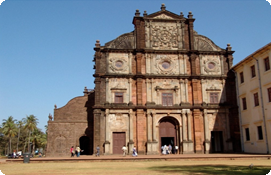 The Basilica of Bom Jesus is
an UNESCO World Heritage site and is considered to be one of the best
examples of baroque architecture. And it is largely visited pilgrimage
site in Goa. It is located in Old Goa, which was then capital of Goa
during the early days of Portuguese reign. The Church is dedicated to
Good Infant Jesus and the most eminent church in Goa. This world
heritage has emerged as a landmark in the history of Christianity for
this Basilica holds the relics of St. Francis Xavier. Patron saint of
Goa, Known as Saib or Gõi-cho Saib of Goa
(Lord of Goa) the Apostle of the Indies. His feast day is
celebrated on 3 December. The construction of the church began in 1594
AD and was consecrated by archbishop Dom Fr. Aleixo de Menezes on the
15th May 1605 AD In 1946 this Jesuit church became India’s
first minor basilica. The Basilica of Bom Jesus is
an UNESCO World Heritage site and is considered to be one of the best
examples of baroque architecture. And it is largely visited pilgrimage
site in Goa. It is located in Old Goa, which was then capital of Goa
during the early days of Portuguese reign. The Church is dedicated to
Good Infant Jesus and the most eminent church in Goa. This world
heritage has emerged as a landmark in the history of Christianity for
this Basilica holds the relics of St. Francis Xavier. Patron saint of
Goa, Known as Saib or Gõi-cho Saib of Goa
(Lord of Goa) the Apostle of the Indies. His feast day is
celebrated on 3 December. The construction of the church began in 1594
AD and was consecrated by archbishop Dom Fr. Aleixo de Menezes on the
15th May 1605 AD In 1946 this Jesuit church became India’s
first minor basilica.
The Basilica, the three story structure is built of
black laterite stone and its architecture from the exterior is a
combination of Corinthian, Doric and Composite style. The front façade
of the Basilica in made of four elements. The lowest part is built of
three elegant entrances. The second part above it has three windows
matching to the three entrances. The third segment has three spherical
windows and the fourth segment is a extravagantly quadrangle decorated
with arabesque art.
The flooring is covered with marble and inlaid with
precious stones. The interior is striking for its simplicity which is
made of Mosaic-Corinthian style. The mausoleum, on the top lies in an
airtight glass coffin the body of St. Francis Xavier positioned in a
silver casket who died on December 3, 1552. In the year 1553, according
to his wishes, his remains were transferred to Goa. It was found that
the saint’s body was as fresh as the day it was buried. In
(1696), the Medicis, Cosimo III, the Grand Duke of
Tuscany a devotee of the Saint gifted the embalmed body of the saint,
which lies in a silver casket that was crafted by a 17th century
Florentine jeweller. The Chapel is also decorated with pictures
representing the life and miracles of the saint. There are many legends
regarding this great saint. The body has not decomposed for centuries.
Its body has healing powers and cure any illness is believed by the
people of Goa, which were experienced by the erstwhile Nizam of
Hyderabad when he came for the Exposition of 1878. Besides his numerous
healings there are many other wonders on St. Francis life He raised 10
from the dead, gifts of tongues, predictions, calming of storm at sea
and more. This miraculous phenomenon continues to attract the devout
from India and overseas, lakhs of pilgrims flock to the Basilica of Bom
Jesus to venerate the body of Saint Francis Xavier every ten years on the anniversary of his death.
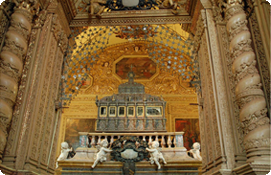 At
the Basilica the Blessed Sacrament is preserved in a tabernacle,
earlier it was kept on the main altar under the statue of St Ignatius,
the founder of Society of Jesus. The statue of St Ignatius is
almost 3 m high and below stands the statue of Infant Jesus. At the
sides are the altar to Our Lady of Mercy and St Michael. The Liturgical
altar was inaugurated on 12th March 1965 which was set up by assembling
the old discarded altars. The chapel and tomb of St Francis Xavier is
to the south of the church. It has three doors on the east, west and
south. The body of St. Francis Xavier was canonization in 1624 AD and
it was brought here from the College of St Paul after his canonization
and shifted to its present location in 1655 AD. A huge picture of
the saint is hung on the last door. At
the Basilica the Blessed Sacrament is preserved in a tabernacle,
earlier it was kept on the main altar under the statue of St Ignatius,
the founder of Society of Jesus. The statue of St Ignatius is
almost 3 m high and below stands the statue of Infant Jesus. At the
sides are the altar to Our Lady of Mercy and St Michael. The Liturgical
altar was inaugurated on 12th March 1965 which was set up by assembling
the old discarded altars. The chapel and tomb of St Francis Xavier is
to the south of the church. It has three doors on the east, west and
south. The body of St. Francis Xavier was canonization in 1624 AD and
it was brought here from the College of St Paul after his canonization
and shifted to its present location in 1655 AD. A huge picture of
the saint is hung on the last door.
The Church is open on Sundays from 10:30 to 18:30hrs
and on weekdays from 9:00 to 18:30 hrs. The Holy Mass is held on
Sundays at 8 & 9:15 hrs and weekdays at 7 & 8 hrs. And the
annual nine-day novenas in preparation for the feast of St Francis
Xavier on December 3, commences on November 24 every year. |
|
| Se Cathedral |
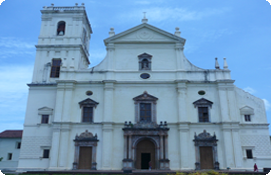 The Se Cathedral is
the cathedral of the Latin Rite Roman Catholic Archdiocese
of Goa and Daman and the seat of the Patriarch of the East
Indies. This magnificent 16th century monument is the largest church
in Asia and took about 80 years to complete. . Located in Old
Goa, India, dedicated to St Catherine in Old Goa. The most
imposing of all churches, the Se Cathedral overpower the visitor with
its splendour and overwhelming presence. The UNESCO has declared it as a
heritage site. The Se Cathedral is
the cathedral of the Latin Rite Roman Catholic Archdiocese
of Goa and Daman and the seat of the Patriarch of the East
Indies. This magnificent 16th century monument is the largest church
in Asia and took about 80 years to complete. . Located in Old
Goa, India, dedicated to St Catherine in Old Goa. The most
imposing of all churches, the Se Cathedral overpower the visitor with
its splendour and overwhelming presence. The UNESCO has declared it as a
heritage site.
The construction of the church began in 1562 under
the reign of King Dom Sebastião. The Cathedral was finally
completed in 1619 and was consecrated in 1640. It was
commissioned by Governor George Cabral to be enlarged in 1552 on the
remains of an earlier structure. The Portuguese Viceroy Redondo
commissioned the Se, or St. Catherine's' Cathedral, southwest
of St. Cajetan Church. Today it stands larger than any church in
Portugal,
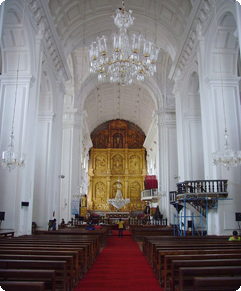 The
Se Cathedral is dedicated to St. Catherine, to commemorate the victory
of the Portuguese under Afonso de Albuquerque over a
Muslim army, as it was on her feast day, 25th November 1510 that
Alfonso de Albuquerque conquered Goa. The Cathedral has five bells and
one of the bells is called the Golden Bell, due to the sweet sound. The
Se Cathedral is dedicated to St. Catherine, to commemorate the victory
of the Portuguese under Afonso de Albuquerque over a
Muslim army, as it was on her feast day, 25th November 1510 that
Alfonso de Albuquerque conquered Goa. The Cathedral has five bells and
one of the bells is called the Golden Bell, due to the sweet sound.
The building is in a Portuguese- Gothic style. It has
a Tuscan exterior and Corinthian interior. The main altar is
dedicated to St. Catherine of Alexandria, and on either side there are
paintings depicting the life and martyrdom of Saint Catherine.
There is a huge gilded reredos above the main altar.
On the right there is a Chapel of the Cross of Miracles, which
is placed in the Cathedral, where a vision of Christ is said to have
appeared in 1919. The Cross was originally erected on hillside by
local shepherds. And the rock on which the Cross was found was said to
spew out water. while the church was being built the cross was stored
nearby, but when the Cross was moved into the new church the doors of
the church had to be widened to accommodate it. In 1845 the Cross was
moved into the Cathedral. Today the Cross is slowly growing.
Se Cathedral also houses a baptismal font made in 1532 which was used
by Saint Francis Xavier, the patron saint of Goa, in order to
baptize several Goan converts.
The adjoining convent has been turned in to an
Archeological Museum and is open to the public daily from 7:30 am to
6:00 pm and all Masses are in Konkani
Mass timings
Sunday: 7:20 am, 10:00 am, 4:00pm
Week days: 7:30 am & 6:00 pm |
|
|
| Chapel of St Catherine |
 The Chapel of St. Catherine is a small chapel one of the magnificently constructed old chapels in Taleigaon, in Tiswadi Taluk which is 5 kms away from Panaji. It is built of laterite stones with a tower on either side of the church. It is located west of the façade of St. Francis of Assisi church. The Church was built in 1510 when Alfonso De Albuquerque took passion of Goan territory on St. Catherin’s Day. Later this chapel was rebuilt in 1552 over the existing remains of the earlier structure and was enlarged by the then Governor, George Cabral who inscribed a stone slab inscripting the entry of Alfonso De Albuquerque who captured Goa from the Muslim rulers. The interior of this chapel has a plain altar. In 1534 A.D owing to a Papal Bill Pope Paul III elevated the status of this chapel to that of a Cathedral. The Chapel of St. Catherine is a small chapel one of the magnificently constructed old chapels in Taleigaon, in Tiswadi Taluk which is 5 kms away from Panaji. It is built of laterite stones with a tower on either side of the church. It is located west of the façade of St. Francis of Assisi church. The Church was built in 1510 when Alfonso De Albuquerque took passion of Goan territory on St. Catherin’s Day. Later this chapel was rebuilt in 1552 over the existing remains of the earlier structure and was enlarged by the then Governor, George Cabral who inscribed a stone slab inscripting the entry of Alfonso De Albuquerque who captured Goa from the Muslim rulers. The interior of this chapel has a plain altar. In 1534 A.D owing to a Papal Bill Pope Paul III elevated the status of this chapel to that of a Cathedral. |
|
| Convent & Church Of St Francis of Assisi |
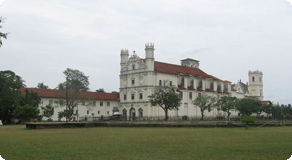 The Convent and Church of St. Francis of Assisi is situated at Old Goa and its origin can be traced back to 1517. Originally this church was a little chapel consecrated to the Holy Ghost in 1521 later in the year 1661, it was transformed the chapel into church by retaining only the entrance of the earlier church. The structure is built of laterite blocks and is lime plastered. The façade of church is towards west. The main entrance has been made in Manuline style, main altar is designed in Baroque with Corinthian characteristics. The Convent and Church of St. Francis of Assisi is situated at Old Goa and its origin can be traced back to 1517. Originally this church was a little chapel consecrated to the Holy Ghost in 1521 later in the year 1661, it was transformed the chapel into church by retaining only the entrance of the earlier church. The structure is built of laterite blocks and is lime plastered. The façade of church is towards west. The main entrance has been made in Manuline style, main altar is designed in Baroque with Corinthian characteristics.
Se Cathedral is linked to the convent and the church of St. Francis of Assisi by the former place of Archbishop, which is lying on the west side of Se Cathedral. Face of the church is towards west, there is a nave surrounded by three small chapels each side, a choir, two sub altars and a main altar in center. Belfry and a sacristy is on the north of main altar, today which you see the houses of Archaeological Museum, was actually a convent, forming annexure to the church. Exhibits at the museum include prehistoric items from a distant tribal past as also reminders of Goa Dourada, Golden Goa, also known as the 'Pearl of the Orient' or 'Rome of the East' during its heyday. It was the concentration of magnificent churches, symbol of a powerful conqueringpresence, which justified this last title.
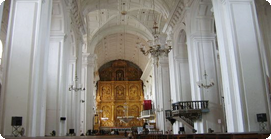 The Chapels and surrounded gallery on top is separated by the internal buttress walls. The statue of Our Lady of Miracles, brought from Jaffna in Sri Lanka, is standing in a forte on the façade. In the main altar there is a large wooden statue of St. Francis of Assisi and an equally large statue of Jesus on the Cross. . Beneath the two figures are inscribed the three vows of the Saint - poverty, humility and obedience. The Chapels and surrounded gallery on top is separated by the internal buttress walls. The statue of Our Lady of Miracles, brought from Jaffna in Sri Lanka, is standing in a forte on the façade. In the main altar there is a large wooden statue of St. Francis of Assisi and an equally large statue of Jesus on the Cross. . Beneath the two figures are inscribed the three vows of the Saint - poverty, humility and obedience.
|
|
| St Augustine church |
 Old Goa has the credit of having a number of churches which have been included in UNESCO list of World Heritage Sites. Among these are the ruins of St. Augustine Church which was perhaps the largest and one of the oldest churches built in Goa by 12 Augustian monks who arrived in Goa on 3rd September 1572. The construction of the church was completed in 1602 AD. Old Goa has the credit of having a number of churches which have been included in UNESCO list of World Heritage Sites. Among these are the ruins of St. Augustine Church which was perhaps the largest and one of the oldest churches built in Goa by 12 Augustian monks who arrived in Goa on 3rd September 1572. The construction of the church was completed in 1602 AD.
Due to the ban imposed by the Portuguese government on Augustines this church and the adjoining convent were deserted leaving it in ruins. The 46-metre high Bell Tower can be seen from a distance, but without the bell. This is one of the four towers of St. Augustine Church. It had eight chapels and four altars richly decorated and a convent found with numerous cells. The bell was first placed in the Fort Aguada Light House, where it remained from 1841 to 1871 AD. Later it was put in the church of Our Lady of Immaculate Conception at Panaji and it is still in working condition. |
|
| Church of St. Cajetan |
 The Church of St. Cajetan was erected in 1661 by Italian friars of the Theatine Order. The Church of St. Cajetan is modelled on the original design of the famous Basilica of St Peter in Rome. Its architecturally Corinthian both externally and internally while the gilded altars with rich carvings are in rich Baroque style. Originally it was called The Church of Our Lady of Divine Providence it was built of laterite blocks which are lime plastered and named after the founder of the Theatine Order, St. Cajetan. The Church of St. Cajetan was erected in 1661 by Italian friars of the Theatine Order. The Church of St. Cajetan is modelled on the original design of the famous Basilica of St Peter in Rome. Its architecturally Corinthian both externally and internally while the gilded altars with rich carvings are in rich Baroque style. Originally it was called The Church of Our Lady of Divine Providence it was built of laterite blocks which are lime plastered and named after the founder of the Theatine Order, St. Cajetan.
The St. Cajetan Church has six Baroque style gilded altars which have figures of angels dominating twisted shafts. The main altar that is dedicated to Our Lady of Divine Providence, To the left the three altars are dedicated to St. Clare, the Holy family and Our Lady of Piety whereas those to the right are dedicated to St. Agnes, St. John and St. Cajetan. Scenes from the life of St. Cajetan are depicted by the Italian school paintings on canvas on the altars.
The Church is open from: 8.30 AM to 5.30 PM |
|
| The St. Anne Church |
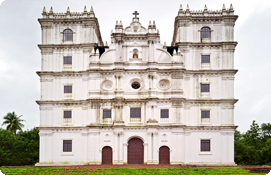 The Church of St. Anne is a religious monument located in hills of Santana, in the Tiswadi taluka in North Goa. Its structure is noted for its excellent baroque architecture and beautiful facade, built on the right hand side of the Siridao River in 1695. The construction was completed by one Fr. Antonio Francisco da Cunha after Mons Francisco do Rego who had originally constructed it. The Church of St. Anne is a religious monument located in hills of Santana, in the Tiswadi taluka in North Goa. Its structure is noted for its excellent baroque architecture and beautiful facade, built on the right hand side of the Siridao River in 1695. The construction was completed by one Fr. Antonio Francisco da Cunha after Mons Francisco do Rego who had originally constructed it.
Legend has it that while construction was in progress, an elderly villager by the name of Bartholomeu Marchon, had a vision of an old lady donning a hat with a staff in hand. The old lady ambled down the neighboring hill and promulgated to Bartholomeu that the Church under construction was her home, and that it was her intent to reside there. A similar apparition was also encountered by a Brahmin lady of high social standing, who happened to be gravely ill and almost in death's clutch. The celestial apparition anointed the lady with a miraculous cure and as a token of supreme gratitude, she embraced Christianity. Word of her miraculous cure percolated down to the village priest who instantly interpreted it as a sign of divine intervention, and without further ado, consecrated the church in honour of St. Anne.
High up in the transept facing the sanctuary, one can see a relief picture depicting the scene of St. Anne with a staff in hand and wearing a hat as seen in the apparitions. The main altar is consecrated to St. Anne. On July 26 the devotees all over Goa celebrate the feast of 'Touceachem Fest' |
|
| The Church of Saint Lawrence |
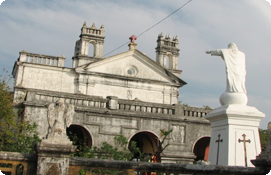 The Church of St. Lawrence at Sinquerim was founded in 1630 by the Count of Linhares, Viceroy Dom Miguel de Noronha when a decision to build a church was taken as soon as the fort was completed. The Church of St. Lawrence at Sinquerim was founded in 1630 by the Count of Linhares, Viceroy Dom Miguel de Noronha when a decision to build a church was taken as soon as the fort was completed.
Saint Lawrence Church was a part of the Aguada fortress, water reservoir and the lighthouse.
The founding and completion of the church is recorded in contemporary inscriptions above the arch of the porch when it was completed in 1643 and attained parish status in 1688. The façade is concealed by a big cloistered porch and has a plain triangular gable with a single round window in the center. And it has a group of buildings with a courtyard and residence and two narrow towers behind it.
The church has limited seating arrangements benches are placed inside the porch making it a convenient and pleasant place for worship. The pillars are decorated with inscriptions depicting the life incidents of St. Lawrence and his martyrdom with white bas relief plaster. Internally, the altar is dedicated to St. Lawrence. His statue is encased in a glass case beneath the baroque reredos. St. Lawrence is known as the Patron Saint of Sailors, he is shown holding a boat in one hand. The panel vaulting is exquisitely decorated and the risers of the steps of the altar have attractive blue and white tiles.
The Church stood as a silent witness to the ups and downs in the political, military and economic history of the Portuguese in India as well as the changing fortunes of Padroado Portuguese do Oriente, later it became a Rectorate of the Franciscans and remained so for about half a century, roughly from the early 1720 to late 1760, when the Franciscans had to quit Bardez and the Diocesan secular clergy took over. The church can be seen from the opposite shore of the Mandovi river and the cemetery with its new cross on a modern concrete pedestal appears as if it has been given a place on the skyline judging by its position on the hill crest.
The festival of St. Lawrence is held each year at the end of the monsoon season, to celebrate the sand bar clearing in order to make the river navigable for ships for the next season. In olden times, the actual cutting of a rope stretched across the river symbolized the celebration of the festival. |
|
| Nossa Senhora De Penha De Franca |
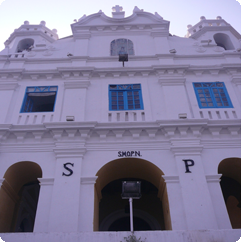 In the year 1626 a church was built in Britona on the banks of the River Mandovi, dedicated to Nossa Senhora De Penha De Franca (Our Lady of Penha OF FRANCE. It was erected by locals who worked in the merchant navy, in gratitude to the Virgin for saving the bubonic plague, which is also seen in Portugal and other Portuguese-speaking countries. But 26 years the Church was rebuilt in 1855 after the fall and in 1932 it was declared a national monument. In 1754, Pope Clement declared that no other church should be dedicated, in order to preserve the eminence of the church in Lisbon. As such only two churches were there in Spain, one was in Madeira and one in the Azores, known for its high peak in Spain. Devotees took pilgrimage here, especially from Portugal. A gilder from Lisbon made nine images of Our Lady under different invocations as a vow of thanks for being spared at the battle of El Ksar el Kebir, against the Moors. He dedicated one to Our Lady of Penha de Franca. He also built a chapel in Lisbon which was completed in 1598. The statue was soon famed for answering pleads, especially in removing plagues and scourges, besides those Churches in 1626 a Church was built on the banks of the Mandovi. Later a tiny chapel was also honoured in the village of Ponolem on the isaland of Colvale, making it rare and privileged few. In the year 1626 a church was built in Britona on the banks of the River Mandovi, dedicated to Nossa Senhora De Penha De Franca (Our Lady of Penha OF FRANCE. It was erected by locals who worked in the merchant navy, in gratitude to the Virgin for saving the bubonic plague, which is also seen in Portugal and other Portuguese-speaking countries. But 26 years the Church was rebuilt in 1855 after the fall and in 1932 it was declared a national monument. In 1754, Pope Clement declared that no other church should be dedicated, in order to preserve the eminence of the church in Lisbon. As such only two churches were there in Spain, one was in Madeira and one in the Azores, known for its high peak in Spain. Devotees took pilgrimage here, especially from Portugal. A gilder from Lisbon made nine images of Our Lady under different invocations as a vow of thanks for being spared at the battle of El Ksar el Kebir, against the Moors. He dedicated one to Our Lady of Penha de Franca. He also built a chapel in Lisbon which was completed in 1598. The statue was soon famed for answering pleads, especially in removing plagues and scourges, besides those Churches in 1626 a Church was built on the banks of the Mandovi. Later a tiny chapel was also honoured in the village of Ponolem on the isaland of Colvale, making it rare and privileged few.
|
|
| Our Lady of the Immaculate Conception |
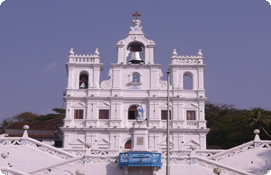 Our Lady of the Immaculate Conception was one of the first church to be built in Goa, in 1541. This early church was re-built in 1619 and to reach the Church an artistic staircase of 100 steps was added to it in a majestic fashion in 1870. The Church is placed majestically atop a hillock just above the Idalco Palace built by Adil Shah, dominating the heart of the city and offering a bird?s eye view of the main square. Our Lady of the Immaculate Conception was one of the first church to be built in Goa, in 1541. This early church was re-built in 1619 and to reach the Church an artistic staircase of 100 steps was added to it in a majestic fashion in 1870. The Church is placed majestically atop a hillock just above the Idalco Palace built by Adil Shah, dominating the heart of the city and offering a bird?s eye view of the main square.
This area was hilly and residential, surrounded by paddy fields, cocunuts groves and watery. In the year 1843 the land was developed by the Viceroy and a square of flowers (Praca de Flores) was built in front of the Church. In the year 1619 the church was re-constructed by enlarging it.
In the year 1871, the great bell belonging to the Augustinian Church of Our Lady in Old Goa was installed at Panjim Church. After the Golden Bell in Se Cathedral, this is second bell which is large in size and heavy in weight about 2,250 kilograms.
The main altar is dedicated to Mary Immaculate, and it has two more altars, on the left is Jesus crucified and to the right is Our Lady of the Rosary. On the both sides there are two marble statues, one of St. Peter and one of St. Paul. On the right of the main altar in the south transept there is a Chapel of St. Francis Xavier. The interior is simple deeply carved ornamentation a fine example of the period.
The feast of the Our Lady of the Immaculate Conception church is celebrated on 8th December in great pomp and religious fervor. During its feast this church is beautifully decorated with lights and decoration and the entire Church Square is occupied by a 3 day fete. |
|
| Santo Estevam Church |
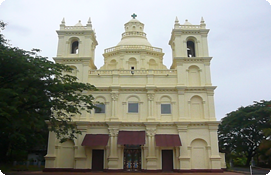 The Santo Estevam Church was built in the year 1759 on the island of Jua near Divar. It was one of the large churches to be built and is special due to its exterior portion resembling a false dome surrounded by twin towers with lanterns. The Church is built in Corinthian style with a nave ceilings decorated with floral graffiti, side altars and elegant pulpit. The main altar of the church is dedicated to St. Stevens. The Statue of St Steven’s stands below a four pillared canopy. The Santo Estevam Church was built in the year 1759 on the island of Jua near Divar. It was one of the large churches to be built and is special due to its exterior portion resembling a false dome surrounded by twin towers with lanterns. The Church is built in Corinthian style with a nave ceilings decorated with floral graffiti, side altars and elegant pulpit. The main altar of the church is dedicated to St. Stevens. The Statue of St Steven’s stands below a four pillared canopy.
From the St. Estevam Village, is the fort of Jua which was originally built to serve as an outpost to protect Ilhas from Muslim invasions. At the top of the fort is an modern shrine dedicated to Christ the King. |
|
| Pilar Seminary |
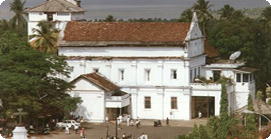 During the reign of Portuguese rule, the Portuguese built four seminaries in Goa, of which two survive, the Rachol Seminary which once housed the Christian Art Museum and the other Seminary is at Pilar, which lies near the village of Goa Velha. This Seminary was founded in 1613 which was named after Our Lady of Pilar, and the statue was brought from Spain, showing our lady standing on a column borne by angels, the ornate, heavily carved and gilded pulpit is a feature of the church During the reign of Portuguese rule, the Portuguese built four seminaries in Goa, of which two survive, the Rachol Seminary which once housed the Christian Art Museum and the other Seminary is at Pilar, which lies near the village of Goa Velha. This Seminary was founded in 1613 which was named after Our Lady of Pilar, and the statue was brought from Spain, showing our lady standing on a column borne by angels, the ornate, heavily carved and gilded pulpit is a feature of the church
The newer wing has a modern chapel with a circular Italian marble platform and a altar and stained glass windows created from stained glass from the paintings of a Goan artist created in Germany. The center piece of which depicts our lady of Pilar.
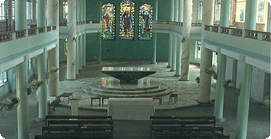 To the right of the front of the church is the chapel containing the tomb of Father Agnelo, where thousands of pilgrims visit each year, masses are held each day especially on Thursday where large stream of worshippers flock to venerate the tomb of Father Agnelo who was the spiritual director of the seminary (1918-1927) The Church at the Seminary has a beautiful exquisite baroque doorway made out of carved stone. Above the doorway holds a statue of St Francis of Assissi and the door has on it a carving of two crossed hands, symbolising Christ and St Francis. Inside there is a small garden, there are cloisters decorated with seventeenth century frescoes. And interesting pictorial depiction of the history of the world, drawn by a missionary in the 1940s and a reredos with Fransiscan saints in the niches. To the right of the front of the church is the chapel containing the tomb of Father Agnelo, where thousands of pilgrims visit each year, masses are held each day especially on Thursday where large stream of worshippers flock to venerate the tomb of Father Agnelo who was the spiritual director of the seminary (1918-1927) The Church at the Seminary has a beautiful exquisite baroque doorway made out of carved stone. Above the doorway holds a statue of St Francis of Assissi and the door has on it a carving of two crossed hands, symbolising Christ and St Francis. Inside there is a small garden, there are cloisters decorated with seventeenth century frescoes. And interesting pictorial depiction of the history of the world, drawn by a missionary in the 1940s and a reredos with Fransiscan saints in the niches.
There is also a small museum, which houses fragments of pottery and temple sculpture excavated from the site including a lion - the Kadamba symbol, Portuguese coins and a beautiful carving of Mary Magdelene done in 1733 by a Goan sculptor. There are also some palm-leaf manuscripts and a copy of the first Marathi translation of the Gospel. |
|
| St Paul Church |
| St. Paul church it consecrated on 25th January, 1543 which is the day of the conversion of St Paul. St Paul church also had a college attached to it known as the St Paul College which was a very famous educational institution in India. Asia’s first printing press was set up here in the year 1556. It was also known for its higher studies which included a Master’s as well Doctorate degree.
Its foundation was laid in the year 1560 in between 1591 and 1675 the building was also set afire four times by some enemies of the Jesuits. This was finally completely demolished in 1829 by the Government except for the façade and the material was taken to Panjim to be utilized for new constructions. It is now in ruins and one can see only an arch in basalt stone which is the facade of the old church.
The church had the sacred relics of St. Francis Xavier preserved in a silver casket and the first public exposition of his incorrupt body after his death, which was later shifted to the Basilica of Bom Jesus. The martyrs of Cuncolim were also buried here.
During the year 1560 a foundation was laid for a bigger church and this building was pulled down. Between 1591 and 1675 the building was also set afire four times by some enemies of the Jesuits. As the building was in a dilapidated state, in the year 1829 the government decided to demolish it. Thus only the archway and some part of the facade can now be seen on the road taken from Old Goa that leads to Ponda. |
|
| Rachol Seminary |
| Rachol seminary is located aboutt 7 kms from the commercial town of Margao, in Salcete taluka. The edifice that presently houses the seminary, was constructed by the Jesuits with donations from the boy-king of Portugal, Dom Sebastião, in the area occupied originally by a Muslim fortress. The foundation stone for the main quadrangular portion was blessed and laid on 1 November 1606 by Fr. Gaspar Soares. Three years later, on 31 October 1609, with the solemn celebration of the Vespers, the “College of All Saints” (Colégio de Todos os Santos) was blessed and inaugurated.
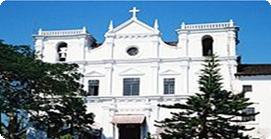 The Seminary has a church built in 1576, dedicated to Saint Ignatius Loyola - the founder of the Jesuit order. Inside the church, there is a statue of Saint Constantine (the first Roman emperor to convert to Christianity), on the richly carved and gilded main altarpiece. It is said that fragments of his bones, brought from Rome in 1782 are enshrined here along with a small glass vial which once contained a little amount of the Saint's blood. These relics are venerated even today in the Church of the seminary
Somewhere between 1622 and 1640, the name of the College was changed to "College of St. Ignatius" (Colégio de S. Inácio). The change was to pay homage to St. Ignatius of Loyola, who had been canonized in 1622. The retable of the main altar of the Seminary Church testifies to this fact. The Seminary community still celebrates the feast of St. Ignatius, the titular of the Seminary Church, with a solemn high mass with Gregorian chant.This festivity is preceded by a novena of preparation for the locals around and a week-long Retreat (Spiritual Exercises) for the seminarians. The Seminary has a church built in 1576, dedicated to Saint Ignatius Loyola - the founder of the Jesuit order. Inside the church, there is a statue of Saint Constantine (the first Roman emperor to convert to Christianity), on the richly carved and gilded main altarpiece. It is said that fragments of his bones, brought from Rome in 1782 are enshrined here along with a small glass vial which once contained a little amount of the Saint's blood. These relics are venerated even today in the Church of the seminary
Somewhere between 1622 and 1640, the name of the College was changed to "College of St. Ignatius" (Colégio de S. Inácio). The change was to pay homage to St. Ignatius of Loyola, who had been canonized in 1622. The retable of the main altar of the Seminary Church testifies to this fact. The Seminary community still celebrates the feast of St. Ignatius, the titular of the Seminary Church, with a solemn high mass with Gregorian chant.This festivity is preceded by a novena of preparation for the locals around and a week-long Retreat (Spiritual Exercises) for the seminarians.
The College continued to be in the hands of the Jesuits for a century and a half. Having begun as a school for the training of natives, it gradually adopted the curriculum for training Jesuits and later even secular priests from 1646. Also the University of Arts, Science and Technology was established here by the Capuchins. It was in the year 1759, Archbishop da Silveira declared Rachol as a diocesan Seminary with the title ‘The Good Sheperd’, Bom Pastor.
In 1759, the Prime Minister of Portugal, Marquis de Pombal expelled the Jesuits from Goa. Their institutions and properties were confiscated by the State. So, the College had to be shut down. In 1762, Archbishop-Primate Dom António Taveira da Neiva Brum e Silveira, converted this abandoned College into the "Diocesan Seminary of the Good Shepherd" (Seminário do Bom Pastor) and placed it under the protection of the Infant Jesus. He entrusted to the native Oratorian Congregation of St. Philip Neri the work of priestly training. This was the first diocesan seminary erected in Asia, after the order passed by the Council of Trent (1563–1578) that all those desiring to dedicate themselves to the ecclesiastical ministry as diocesan (secular) clergy should pass through formation in a Seminary. The retable of the altar of the internal Chapel of the seminary bears an inspiring picture of Jesus, the Good Shepherd. The Church, however, continued under the invocation of St. Ignatius of Loyola.
In 1774, the ruling Royal Treasury Junta of Goa, abruptly suppressed the seminary on the pretext that certain conditions were not being fulfilled, the real reason being that of economy. In 1781, owing to a mass-petition by the people of Salcete and the Municipality of Margao, the Court of Portugal ordered the seminary to be restored.. The seminary functioned well till 1790, when it was closed down for three years, after the Vincentians left the seminary. In 1793, the Oratorians were again deputed to run the diocesan seminary. They continued their work for about forty-two years.
In 1835 all religious institutes were extinguished in Portugal and in all its possessions. So from that year, the Seminary is run by the diocesan clergy and came to be simply known asSeminário de Rachol. In 1886, the Archbishop of Goa and Daman was bestowed the honorific title of Patriarch of the East Indies. Since then the seminary is known as the "Patriarchal Seminary of Rachol". |
|
| Igreja de Nossa Senhora de Piedade |
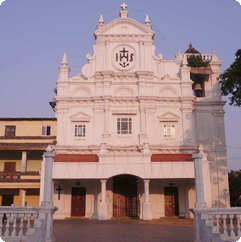 Igreja de Nossa Senhora de Piedade was founded in 1630 in Colva also known as Our Lady famous for the white washed Church. In the Church it has miraculous statue of 'Menino Jesus' (Baby Jesus) which is believed to have healing powers that was founded by a Jesuit missionary. Igreja de Nossa Senhora de Piedade was founded in 1630 in Colva also known as Our Lady famous for the white washed Church. In the Church it has miraculous statue of 'Menino Jesus' (Baby Jesus) which is believed to have healing powers that was founded by a Jesuit missionary. According to local legend the statue in Our Lady of Mercy church was found in the mid-seventeenth century in the coast of Mozambique, when Rev Father Bento Ferreira and his group were shipwrecked off the coast. After swimming to safety they spotted the statute which was washed ashore after being dumped by Muslim pirates into the sea. In 1648 when Father Ferreira was posted to Colva he placed the statue on the altar and it soon started drawing large crowds of devotees as it granted their favours. The Menino Jesus statue is kept for public viewing in October during the annual festival called Fama ('Fame') where thousands of devotees flock to the Church. During this festive season the statue is removed from the vault. |
|
| Church of the Holy Spirit |
 Holy Spirit Church is located in the village of Zambaulim 22 kms from Margao. In the surroundings you get to see many old Portuguese mansions around the a square called Church Square or Largo de Igrega. The Church was originally built in 1564 but was destroyed in 1571 and rebuilt in 1645 and Church was consecrated in 1675. The church houses a huge cross that dates back to the late 17th century. Holy Spirit Church is located in the village of Zambaulim 22 kms from Margao. In the surroundings you get to see many old Portuguese mansions around the a square called Church Square or Largo de Igrega. The Church was originally built in 1564 but was destroyed in 1571 and rebuilt in 1645 and Church was consecrated in 1675. The church houses a huge cross that dates back to the late 17th century.
Its architecture is built of the Baroque style and Its interior are ornately with glit crystals and stucco carved from ceiling to ground. The inside altars are dedicated to Immaculate Conception of Mary, St Peter, St. Michael etc. The feast day of the church is celebrated on June 10. |
|
| Convent of St. Monica |
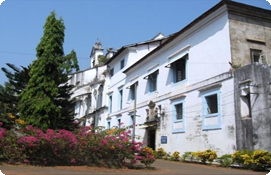 The Convent of St. Monica was Goa’s only convent for nuns dating from 1627. Its construction of this massive nunnery started in 1606 and reached completion in 1627. It was once called 'Royal Monastery of Santa Monica' the convent was the abode of around 150 cloistered nuns, called the daughters of St. Monica .and acclaimed as the first nunnery of the East. In the year 1636 it was burned down but rebuilt in the year 1637 The Convent of St. Monica was Goa’s only convent for nuns dating from 1627. Its construction of this massive nunnery started in 1606 and reached completion in 1627. It was once called 'Royal Monastery of Santa Monica' the convent was the abode of around 150 cloistered nuns, called the daughters of St. Monica .and acclaimed as the first nunnery of the East. In the year 1636 it was burned down but rebuilt in the year 1637
The Convent of St. Monica was granted the status of a church in 1968 dedicated to St. Monica, which has the famous Chapel of the Weeping Cross. The cross is believed to be miraculous and it is said that in 1636 Christ opened his eyes and blood oozed from his crown of thorns. In addition to the main altar there was also a row of black faced statues known as the Black Virgins long ago. It came to be known that their black color was a result of the tarnish from the candles lit at their feet.
The convent is currently occupied by nuns from the Mater Dei Institute. And in a renovated section of the convent of St. Monica is the Museum of Christian Art where contribution from the 16th to 19th centuries of the Hindus to Christian art is displayed. This includes objects such as silver crowns, ivory ornaments, 17 century manuscripts and statues. The external architecture of the St. Monica church is a union of the Tuscan, Corinthian and composite styles, while it’s interior unify the Doric and composite styles. The main contains the image of Santa Monica, mother of St. Augustine, to whom the convent and the church is dedicated. The external front façade of the church features the statue of Santa Monica and the symbol of the Holy Ghost. The Church is open to worshipers’ and visitors all days from 9.30 am to 5 pm.
|
|
| Chapel of Our Lady of the Mount |
 The Chapel of Our Lady of the Mount is situated on top of the hill, about 2-kms from the main road towards Ponda that passes through the Arch of Conception and the Chapel is next to “Handmaids of Christ” convent opposite the façade of the Se Cathedral. The chapel was built in 1510 by Alfonso de Albuquerque after his victory over the Goan Muslim ruler Yusuf Shah. The Chapel was reconstructed twice. To pathway to the Chapel is lead through a serious of steps which is built of laterite plastered with lime mortar. The Chapel has three main altars dedicated to Our Lady of the Mount, St. Anthony and St. Andrew. The Chapel of Our Lady of the Mount is situated on top of the hill, about 2-kms from the main road towards Ponda that passes through the Arch of Conception and the Chapel is next to “Handmaids of Christ” convent opposite the façade of the Se Cathedral. The chapel was built in 1510 by Alfonso de Albuquerque after his victory over the Goan Muslim ruler Yusuf Shah. The Chapel was reconstructed twice. To pathway to the Chapel is lead through a serious of steps which is built of laterite plastered with lime mortar. The Chapel has three main altars dedicated to Our Lady of the Mount, St. Anthony and St. Andrew.
The structure faces a picturesque view of Divar and Charao islans, the Mandovi River and the surrounding forested hills. It also offers the overview of Old Goa where in 1510 Sultan Adil Shah's placed his artillery to defend the city from the Portuguese assault. |
|
| Church of Our Lady of Compassion |
 The Church of Our Lady of Compassion is locaited in Piedade, a Goan village which is located at the bottom of a small, forested hill on Divar Island. The church designed by a Goan priest is known to be the first Christian structure erected here and is a charismatic building dating from the early 18th century. The interior features interesting stuccowork, Barogue plaster decorations and altars. The Church was rebuilt to include an impressive Indian baroque façade. Views from the top of the hill offer impressive panoramic views of the surrounding countryside including Old Goa and the River Mandovi. The Church of Our Lady of Compassion is locaited in Piedade, a Goan village which is located at the bottom of a small, forested hill on Divar Island. The church designed by a Goan priest is known to be the first Christian structure erected here and is a charismatic building dating from the early 18th century. The interior features interesting stuccowork, Barogue plaster decorations and altars. The Church was rebuilt to include an impressive Indian baroque façade. Views from the top of the hill offer impressive panoramic views of the surrounding countryside including Old Goa and the River Mandovi.
To the south side of the church of Our Lady of Compassion one can see a remnant of the illustrious Kadamba era. A huge statue of St. Francis of Assisi and the statue of Jesus on the cross which is equally huge lies in the main altar above tabernacle. On the both side of main altars paintings are displayed on woods depicting the life of St. Francis of Assisi. |
|
| Church of Our Lady of Miracles |
 The Church of Our Lady of Miracles is situated at Sanguem which is 2kms from Mapusa. It was originally a military chapel built by the Portuguese Government and under the jurisdiction of the Zambaulim church. This Church was constructed in the year 1594. is a prominent tourist spots in Goa . The Church of Our Lady of Miracles is situated at Sanguem which is 2kms from Mapusa. It was originally a military chapel built by the Portuguese Government and under the jurisdiction of the Zambaulim church. This Church was constructed in the year 1594. is a prominent tourist spots in Goa .
In 1951, Sanguem taluka was declared as Mission and was handed over to the Pilar Fathers. Many Pilar Fathers worked hard to collect funds to build the church and some of them include Fr Assis Dias, Fr Francis Sequeira, Fr Xavier Pinto and Fr Joao Santan Sequeira.
In 1977, the old church was demolished and a new church was built. The Parish feast is celebrated on the 2nd Sunday of May. The Church is known for its miraculous powers for receiving healing and peace. Devotees folk to this Church every Friday to conduct prayers in large numbers.
people of Sanguem are loving and God fearing. They have a great devotion to Our Lady. Every Friday, praise and worship is conducted in the church. The church is always packed and many Hindu brothers and sisters also partake in the worship. In this place several people receive miracles of healing and peace.
The Parish witnesses a lot of harmony between other faiths coming from Hindus and Muslims, who have a strong devotion to Our Lady of Miracles. |
|
| St Clara's Church at Assonora |
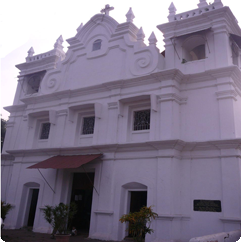 The chapel situated at Assonora was known as the St. Clara of Assisi chapel. It was built in the early year of 1768 by the Franciscan Friars in the late 17th century. The Chapel was elevated in October 18 1805 to the status of The St Clara's church. On several occasions it was brunt down by the Marathas. However, it was rebuilt every time it was destroyed. The chapel situated at Assonora was known as the St. Clara of Assisi chapel. It was built in the early year of 1768 by the Franciscan Friars in the late 17th century. The Chapel was elevated in October 18 1805 to the status of The St Clara's church. On several occasions it was brunt down by the Marathas. However, it was rebuilt every time it was destroyed.
In the interiors the church of St Clara has five altars, one of which is dedicated to Santa Clara. In the year 2001, the church constructed a hall for the parish and Village activities. The church is well known for its Friday's inner-healing sessions that attract huge crowds. Youth retreats held here also receive wide support. This feast of this church is celebrated on 2nd Saturday of May every year with great enthusiasm. |
|
|
| |
|


 Goa is India's most beautiful state and worlds renowned holiday
destination. It is the ideal location for the perfect tropical holiday.
An unrivalled beach location, Goa is blessed with many relaxed beaches
offering a variety of activities and amenities, and breathtaking views
of the ocean. Goa’s legendary white golden sandy beaches will leave you
with memories that last a lifetime to name a few beaches in North Goa
are Dona Paula, Calangute, Vagator, Anjuna, Baga, Miramar, Arambol and
in South Goa the beaches are Colva, Benaulim, Varca, Palolem, Mobor,
Patmen, Galgibaga and Bogmalo Beach.
Goa is India's most beautiful state and worlds renowned holiday
destination. It is the ideal location for the perfect tropical holiday.
An unrivalled beach location, Goa is blessed with many relaxed beaches
offering a variety of activities and amenities, and breathtaking views
of the ocean. Goa’s legendary white golden sandy beaches will leave you
with memories that last a lifetime to name a few beaches in North Goa
are Dona Paula, Calangute, Vagator, Anjuna, Baga, Miramar, Arambol and
in South Goa the beaches are Colva, Benaulim, Varca, Palolem, Mobor,
Patmen, Galgibaga and Bogmalo Beach.

 There
is more about Goa when we talk about mouth watering Goan cuisine. Goan
cuisine is famous for its rich sea food dishes. Goan food has distinct
tastes and influenced by the Goan Hindu and Goan Catholic cooking
styles. Goan cuisine also has strong influence of Portuguese cuisine
that it came contact with during the four hundred years of Portuguese
colonialism such as the Bebinca prepared during the festive Christmas
season and the exotic Goan vegetable stew known as Khatkhate prepared
during the festivals. One cannot miss the Goan delicacies such as pork
dishes Vindaloo, Sorpotel, Chicken Xacuti that are prepared during the
major festive occasions. Besides mouth watering exotic food Goa is also
famous for its national drink Feni. The most popular alcoholic
beverage called Cashew Feni made from Cashew fruit and Coconut Feni
made from the sap of toddy palms.
There
is more about Goa when we talk about mouth watering Goan cuisine. Goan
cuisine is famous for its rich sea food dishes. Goan food has distinct
tastes and influenced by the Goan Hindu and Goan Catholic cooking
styles. Goan cuisine also has strong influence of Portuguese cuisine
that it came contact with during the four hundred years of Portuguese
colonialism such as the Bebinca prepared during the festive Christmas
season and the exotic Goan vegetable stew known as Khatkhate prepared
during the festivals. One cannot miss the Goan delicacies such as pork
dishes Vindaloo, Sorpotel, Chicken Xacuti that are prepared during the
major festive occasions. Besides mouth watering exotic food Goa is also
famous for its national drink Feni. The most popular alcoholic
beverage called Cashew Feni made from Cashew fruit and Coconut Feni
made from the sap of toddy palms.

 Viva Goa!
Viva Goa!  The Basilica of Bom Jesus is
an UNESCO World Heritage site and is considered to be one of the best
examples of baroque architecture. And it is largely visited pilgrimage
site in Goa. It is located in Old Goa, which was then capital of Goa
during the early days of Portuguese reign. The Church is dedicated to
Good Infant Jesus and the most eminent church in Goa. This world
heritage has emerged as a landmark in the history of Christianity for
this Basilica holds the relics of St. Francis Xavier. Patron saint of
Goa, Known as Saib or Gõi-cho Saib of Goa
(Lord of Goa) the Apostle of the Indies. His feast day is
celebrated on 3 December. The construction of the church began in 1594
AD and was consecrated by archbishop Dom Fr. Aleixo de Menezes on the
15th May 1605 AD In 1946 this Jesuit church became India’s
first minor basilica.
The Basilica of Bom Jesus is
an UNESCO World Heritage site and is considered to be one of the best
examples of baroque architecture. And it is largely visited pilgrimage
site in Goa. It is located in Old Goa, which was then capital of Goa
during the early days of Portuguese reign. The Church is dedicated to
Good Infant Jesus and the most eminent church in Goa. This world
heritage has emerged as a landmark in the history of Christianity for
this Basilica holds the relics of St. Francis Xavier. Patron saint of
Goa, Known as Saib or Gõi-cho Saib of Goa
(Lord of Goa) the Apostle of the Indies. His feast day is
celebrated on 3 December. The construction of the church began in 1594
AD and was consecrated by archbishop Dom Fr. Aleixo de Menezes on the
15th May 1605 AD In 1946 this Jesuit church became India’s
first minor basilica.
 At
the Basilica the Blessed Sacrament is preserved in a tabernacle,
earlier it was kept on the main altar under the statue of St Ignatius,
the founder of Society of Jesus. The statue of St Ignatius is
almost 3 m high and below stands the statue of Infant Jesus. At the
sides are the altar to Our Lady of Mercy and St Michael. The Liturgical
altar was inaugurated on 12th March 1965 which was set up by assembling
the old discarded altars. The chapel and tomb of St Francis Xavier is
to the south of the church. It has three doors on the east, west and
south. The body of St. Francis Xavier was canonization in 1624 AD and
it was brought here from the College of St Paul after his canonization
and shifted to its present location in 1655 AD. A huge picture of
the saint is hung on the last door.
At
the Basilica the Blessed Sacrament is preserved in a tabernacle,
earlier it was kept on the main altar under the statue of St Ignatius,
the founder of Society of Jesus. The statue of St Ignatius is
almost 3 m high and below stands the statue of Infant Jesus. At the
sides are the altar to Our Lady of Mercy and St Michael. The Liturgical
altar was inaugurated on 12th March 1965 which was set up by assembling
the old discarded altars. The chapel and tomb of St Francis Xavier is
to the south of the church. It has three doors on the east, west and
south. The body of St. Francis Xavier was canonization in 1624 AD and
it was brought here from the College of St Paul after his canonization
and shifted to its present location in 1655 AD. A huge picture of
the saint is hung on the last door.
 The Se Cathedral is
the cathedral of the Latin Rite Roman Catholic Archdiocese
of Goa and Daman and the seat of the Patriarch of the East
Indies. This magnificent 16th century monument is the largest church
in Asia and took about 80 years to complete. . Located in Old
Goa, India, dedicated to St Catherine in Old Goa. The most
imposing of all churches, the Se Cathedral overpower the visitor with
its splendour and overwhelming presence. The UNESCO has declared it as a
heritage site.
The Se Cathedral is
the cathedral of the Latin Rite Roman Catholic Archdiocese
of Goa and Daman and the seat of the Patriarch of the East
Indies. This magnificent 16th century monument is the largest church
in Asia and took about 80 years to complete. . Located in Old
Goa, India, dedicated to St Catherine in Old Goa. The most
imposing of all churches, the Se Cathedral overpower the visitor with
its splendour and overwhelming presence. The UNESCO has declared it as a
heritage site.
 The
Se Cathedral is dedicated to St. Catherine, to commemorate the victory
of the Portuguese under Afonso de Albuquerque over a
Muslim army, as it was on her feast day, 25th November 1510 that
Alfonso de Albuquerque conquered Goa. The Cathedral has five bells and
one of the bells is called the Golden Bell, due to the sweet sound.
The
Se Cathedral is dedicated to St. Catherine, to commemorate the victory
of the Portuguese under Afonso de Albuquerque over a
Muslim army, as it was on her feast day, 25th November 1510 that
Alfonso de Albuquerque conquered Goa. The Cathedral has five bells and
one of the bells is called the Golden Bell, due to the sweet sound.
 The Chapel of St. Catherine is a small chapel one of the magnificently constructed old chapels in Taleigaon, in Tiswadi Taluk which is 5 kms away from Panaji. It is built of laterite stones with a tower on either side of the church. It is located west of the façade of St. Francis of Assisi church. The Church was built in 1510 when Alfonso De Albuquerque took passion of Goan territory on St. Catherin’s Day. Later this chapel was rebuilt in 1552 over the existing remains of the earlier structure and was enlarged by the then Governor, George Cabral who inscribed a stone slab inscripting the entry of Alfonso De Albuquerque who captured Goa from the Muslim rulers. The interior of this chapel has a plain altar. In 1534 A.D owing to a Papal Bill Pope Paul III elevated the status of this chapel to that of a Cathedral.
The Chapel of St. Catherine is a small chapel one of the magnificently constructed old chapels in Taleigaon, in Tiswadi Taluk which is 5 kms away from Panaji. It is built of laterite stones with a tower on either side of the church. It is located west of the façade of St. Francis of Assisi church. The Church was built in 1510 when Alfonso De Albuquerque took passion of Goan territory on St. Catherin’s Day. Later this chapel was rebuilt in 1552 over the existing remains of the earlier structure and was enlarged by the then Governor, George Cabral who inscribed a stone slab inscripting the entry of Alfonso De Albuquerque who captured Goa from the Muslim rulers. The interior of this chapel has a plain altar. In 1534 A.D owing to a Papal Bill Pope Paul III elevated the status of this chapel to that of a Cathedral.  The Convent and Church of St. Francis of Assisi is situated at Old Goa and its origin can be traced back to 1517. Originally this church was a little chapel consecrated to the Holy Ghost in 1521 later in the year 1661, it was transformed the chapel into church by retaining only the entrance of the earlier church. The structure is built of laterite blocks and is lime plastered. The façade of church is towards west. The main entrance has been made in Manuline style, main altar is designed in Baroque with Corinthian characteristics.
The Convent and Church of St. Francis of Assisi is situated at Old Goa and its origin can be traced back to 1517. Originally this church was a little chapel consecrated to the Holy Ghost in 1521 later in the year 1661, it was transformed the chapel into church by retaining only the entrance of the earlier church. The structure is built of laterite blocks and is lime plastered. The façade of church is towards west. The main entrance has been made in Manuline style, main altar is designed in Baroque with Corinthian characteristics.  The Chapels and surrounded gallery on top is separated by the internal buttress walls. The statue of Our Lady of Miracles, brought from Jaffna in Sri Lanka, is standing in a forte on the façade. In the main altar there is a large wooden statue of St. Francis of Assisi and an equally large statue of Jesus on the Cross. . Beneath the two figures are inscribed the three vows of the Saint - poverty, humility and obedience.
The Chapels and surrounded gallery on top is separated by the internal buttress walls. The statue of Our Lady of Miracles, brought from Jaffna in Sri Lanka, is standing in a forte on the façade. In the main altar there is a large wooden statue of St. Francis of Assisi and an equally large statue of Jesus on the Cross. . Beneath the two figures are inscribed the three vows of the Saint - poverty, humility and obedience.  Old Goa has the credit of having a number of churches which have been included in UNESCO list of World Heritage Sites. Among these are the ruins of St. Augustine Church which was perhaps the largest and one of the oldest churches built in Goa by 12 Augustian monks who arrived in Goa on 3rd September 1572. The construction of the church was completed in 1602 AD.
Old Goa has the credit of having a number of churches which have been included in UNESCO list of World Heritage Sites. Among these are the ruins of St. Augustine Church which was perhaps the largest and one of the oldest churches built in Goa by 12 Augustian monks who arrived in Goa on 3rd September 1572. The construction of the church was completed in 1602 AD.  The Church of St. Cajetan was erected in 1661 by Italian friars of the Theatine Order. The Church of St. Cajetan is modelled on the original design of the famous Basilica of St Peter in Rome. Its architecturally Corinthian both externally and internally while the gilded altars with rich carvings are in rich Baroque style. Originally it was called The Church of Our Lady of Divine Providence it was built of laterite blocks which are lime plastered and named after the founder of the Theatine Order, St. Cajetan.
The Church of St. Cajetan was erected in 1661 by Italian friars of the Theatine Order. The Church of St. Cajetan is modelled on the original design of the famous Basilica of St Peter in Rome. Its architecturally Corinthian both externally and internally while the gilded altars with rich carvings are in rich Baroque style. Originally it was called The Church of Our Lady of Divine Providence it was built of laterite blocks which are lime plastered and named after the founder of the Theatine Order, St. Cajetan.
 The Church of St. Anne is a religious monument located in hills of Santana, in the Tiswadi taluka in North Goa. Its structure is noted for its excellent baroque architecture and beautiful facade, built on the right hand side of the Siridao River in 1695. The construction was completed by one Fr. Antonio Francisco da Cunha after Mons Francisco do Rego who had originally constructed it.
The Church of St. Anne is a religious monument located in hills of Santana, in the Tiswadi taluka in North Goa. Its structure is noted for its excellent baroque architecture and beautiful facade, built on the right hand side of the Siridao River in 1695. The construction was completed by one Fr. Antonio Francisco da Cunha after Mons Francisco do Rego who had originally constructed it.
 The Church of St. Lawrence at Sinquerim was founded in 1630 by the Count of Linhares, Viceroy Dom Miguel de Noronha when a decision to build a church was taken as soon as the fort was completed.
The Church of St. Lawrence at Sinquerim was founded in 1630 by the Count of Linhares, Viceroy Dom Miguel de Noronha when a decision to build a church was taken as soon as the fort was completed.
 In the year 1626 a church was built in Britona on the banks of the River Mandovi, dedicated to Nossa Senhora De Penha De Franca (Our Lady of Penha OF FRANCE. It was erected by locals who worked in the merchant navy, in gratitude to the Virgin for saving the bubonic plague, which is also seen in Portugal and other Portuguese-speaking countries. But 26 years the Church was rebuilt in 1855 after the fall and in 1932 it was declared a national monument. In 1754, Pope Clement declared that no other church should be dedicated, in order to preserve the eminence of the church in Lisbon. As such only two churches were there in Spain, one was in Madeira and one in the Azores, known for its high peak in Spain. Devotees took pilgrimage here, especially from Portugal. A gilder from Lisbon made nine images of Our Lady under different invocations as a vow of thanks for being spared at the battle of El Ksar el Kebir, against the Moors. He dedicated one to Our Lady of Penha de Franca. He also built a chapel in Lisbon which was completed in 1598. The statue was soon famed for answering pleads, especially in removing plagues and scourges, besides those Churches in 1626 a Church was built on the banks of the Mandovi. Later a tiny chapel was also honoured in the village of Ponolem on the isaland of Colvale, making it rare and privileged few.
In the year 1626 a church was built in Britona on the banks of the River Mandovi, dedicated to Nossa Senhora De Penha De Franca (Our Lady of Penha OF FRANCE. It was erected by locals who worked in the merchant navy, in gratitude to the Virgin for saving the bubonic plague, which is also seen in Portugal and other Portuguese-speaking countries. But 26 years the Church was rebuilt in 1855 after the fall and in 1932 it was declared a national monument. In 1754, Pope Clement declared that no other church should be dedicated, in order to preserve the eminence of the church in Lisbon. As such only two churches were there in Spain, one was in Madeira and one in the Azores, known for its high peak in Spain. Devotees took pilgrimage here, especially from Portugal. A gilder from Lisbon made nine images of Our Lady under different invocations as a vow of thanks for being spared at the battle of El Ksar el Kebir, against the Moors. He dedicated one to Our Lady of Penha de Franca. He also built a chapel in Lisbon which was completed in 1598. The statue was soon famed for answering pleads, especially in removing plagues and scourges, besides those Churches in 1626 a Church was built on the banks of the Mandovi. Later a tiny chapel was also honoured in the village of Ponolem on the isaland of Colvale, making it rare and privileged few.  Our Lady of the Immaculate Conception was one of the first church to be built in Goa, in 1541. This early church was re-built in 1619 and to reach the Church an artistic staircase of 100 steps was added to it in a majestic fashion in 1870. The Church is placed majestically atop a hillock just above the Idalco Palace built by Adil Shah, dominating the heart of the city and offering a bird?s eye view of the main square.
Our Lady of the Immaculate Conception was one of the first church to be built in Goa, in 1541. This early church was re-built in 1619 and to reach the Church an artistic staircase of 100 steps was added to it in a majestic fashion in 1870. The Church is placed majestically atop a hillock just above the Idalco Palace built by Adil Shah, dominating the heart of the city and offering a bird?s eye view of the main square.  The Santo Estevam Church was built in the year 1759 on the island of Jua near Divar. It was one of the large churches to be built and is special due to its exterior portion resembling a false dome surrounded by twin towers with lanterns. The Church is built in Corinthian style with a nave ceilings decorated with floral graffiti, side altars and elegant pulpit. The main altar of the church is dedicated to St. Stevens. The Statue of St Steven’s stands below a four pillared canopy.
The Santo Estevam Church was built in the year 1759 on the island of Jua near Divar. It was one of the large churches to be built and is special due to its exterior portion resembling a false dome surrounded by twin towers with lanterns. The Church is built in Corinthian style with a nave ceilings decorated with floral graffiti, side altars and elegant pulpit. The main altar of the church is dedicated to St. Stevens. The Statue of St Steven’s stands below a four pillared canopy. During the reign of Portuguese rule, the Portuguese built four seminaries in Goa, of which two survive, the Rachol Seminary which once housed the Christian Art Museum and the other Seminary is at Pilar, which lies near the village of Goa Velha. This Seminary was founded in 1613 which was named after Our Lady of Pilar, and the statue was brought from Spain, showing our lady standing on a column borne by angels, the ornate, heavily carved and gilded pulpit is a feature of the church
During the reign of Portuguese rule, the Portuguese built four seminaries in Goa, of which two survive, the Rachol Seminary which once housed the Christian Art Museum and the other Seminary is at Pilar, which lies near the village of Goa Velha. This Seminary was founded in 1613 which was named after Our Lady of Pilar, and the statue was brought from Spain, showing our lady standing on a column borne by angels, the ornate, heavily carved and gilded pulpit is a feature of the church  To the right of the front of the church is the chapel containing the tomb of Father Agnelo, where thousands of pilgrims visit each year, masses are held each day especially on Thursday where large stream of worshippers flock to venerate the tomb of Father Agnelo who was the spiritual director of the seminary (1918-1927) The Church at the Seminary has a beautiful exquisite baroque doorway made out of carved stone. Above the doorway holds a statue of St Francis of Assissi and the door has on it a carving of two crossed hands, symbolising Christ and St Francis. Inside there is a small garden, there are cloisters decorated with seventeenth century frescoes. And interesting pictorial depiction of the history of the world, drawn by a missionary in the 1940s and a reredos with Fransiscan saints in the niches.
To the right of the front of the church is the chapel containing the tomb of Father Agnelo, where thousands of pilgrims visit each year, masses are held each day especially on Thursday where large stream of worshippers flock to venerate the tomb of Father Agnelo who was the spiritual director of the seminary (1918-1927) The Church at the Seminary has a beautiful exquisite baroque doorway made out of carved stone. Above the doorway holds a statue of St Francis of Assissi and the door has on it a carving of two crossed hands, symbolising Christ and St Francis. Inside there is a small garden, there are cloisters decorated with seventeenth century frescoes. And interesting pictorial depiction of the history of the world, drawn by a missionary in the 1940s and a reredos with Fransiscan saints in the niches.  The Seminary has a church built in 1576, dedicated to Saint Ignatius Loyola - the founder of the Jesuit order. Inside the church, there is a statue of Saint Constantine (the first Roman emperor to convert to Christianity), on the richly carved and gilded main altarpiece. It is said that fragments of his bones, brought from Rome in 1782 are enshrined here along with a small glass vial which once contained a little amount of the Saint's blood. These relics are venerated even today in the Church of the seminary
Somewhere between 1622 and 1640, the name of the College was changed to "College of St. Ignatius" (Colégio de S. Inácio). The change was to pay homage to St. Ignatius of Loyola, who had been canonized in 1622. The retable of the main altar of the Seminary Church testifies to this fact. The Seminary community still celebrates the feast of St. Ignatius, the titular of the Seminary Church, with a solemn high mass with Gregorian chant.This festivity is preceded by a novena of preparation for the locals around and a week-long Retreat (Spiritual Exercises) for the seminarians.
The Seminary has a church built in 1576, dedicated to Saint Ignatius Loyola - the founder of the Jesuit order. Inside the church, there is a statue of Saint Constantine (the first Roman emperor to convert to Christianity), on the richly carved and gilded main altarpiece. It is said that fragments of his bones, brought from Rome in 1782 are enshrined here along with a small glass vial which once contained a little amount of the Saint's blood. These relics are venerated even today in the Church of the seminary
Somewhere between 1622 and 1640, the name of the College was changed to "College of St. Ignatius" (Colégio de S. Inácio). The change was to pay homage to St. Ignatius of Loyola, who had been canonized in 1622. The retable of the main altar of the Seminary Church testifies to this fact. The Seminary community still celebrates the feast of St. Ignatius, the titular of the Seminary Church, with a solemn high mass with Gregorian chant.This festivity is preceded by a novena of preparation for the locals around and a week-long Retreat (Spiritual Exercises) for the seminarians. Igreja de Nossa Senhora de Piedade was founded in 1630 in Colva also known as Our Lady famous for the white washed Church. In the Church it has miraculous statue of 'Menino Jesus' (Baby Jesus) which is believed to have healing powers that was founded by a Jesuit missionary.
Igreja de Nossa Senhora de Piedade was founded in 1630 in Colva also known as Our Lady famous for the white washed Church. In the Church it has miraculous statue of 'Menino Jesus' (Baby Jesus) which is believed to have healing powers that was founded by a Jesuit missionary.  Holy Spirit Church is located in the village of Zambaulim 22 kms from Margao. In the surroundings you get to see many old Portuguese mansions around the a square called Church Square or Largo de Igrega. The Church was originally built in 1564 but was destroyed in 1571 and rebuilt in 1645 and Church was consecrated in 1675. The church houses a huge cross that dates back to the late 17th century.
Holy Spirit Church is located in the village of Zambaulim 22 kms from Margao. In the surroundings you get to see many old Portuguese mansions around the a square called Church Square or Largo de Igrega. The Church was originally built in 1564 but was destroyed in 1571 and rebuilt in 1645 and Church was consecrated in 1675. The church houses a huge cross that dates back to the late 17th century.  The Convent of St. Monica was Goa’s only convent for nuns dating from 1627. Its construction of this massive nunnery started in 1606 and reached completion in 1627. It was once called 'Royal Monastery of Santa Monica' the convent was the abode of around 150 cloistered nuns, called the daughters of St. Monica .and acclaimed as the first nunnery of the East. In the year 1636 it was burned down but rebuilt in the year 1637
The Convent of St. Monica was Goa’s only convent for nuns dating from 1627. Its construction of this massive nunnery started in 1606 and reached completion in 1627. It was once called 'Royal Monastery of Santa Monica' the convent was the abode of around 150 cloistered nuns, called the daughters of St. Monica .and acclaimed as the first nunnery of the East. In the year 1636 it was burned down but rebuilt in the year 1637  The Chapel of Our Lady of the Mount is situated on top of the hill, about 2-kms from the main road towards Ponda that passes through the Arch of Conception and the Chapel is next to “Handmaids of Christ” convent opposite the façade of the Se Cathedral. The chapel was built in 1510 by Alfonso de Albuquerque after his victory over the Goan Muslim ruler Yusuf Shah. The Chapel was reconstructed twice. To pathway to the Chapel is lead through a serious of steps which is built of laterite plastered with lime mortar. The Chapel has three main altars dedicated to Our Lady of the Mount, St. Anthony and St. Andrew.
The Chapel of Our Lady of the Mount is situated on top of the hill, about 2-kms from the main road towards Ponda that passes through the Arch of Conception and the Chapel is next to “Handmaids of Christ” convent opposite the façade of the Se Cathedral. The chapel was built in 1510 by Alfonso de Albuquerque after his victory over the Goan Muslim ruler Yusuf Shah. The Chapel was reconstructed twice. To pathway to the Chapel is lead through a serious of steps which is built of laterite plastered with lime mortar. The Chapel has three main altars dedicated to Our Lady of the Mount, St. Anthony and St. Andrew. The Church of Our Lady of Compassion is locaited in Piedade, a Goan village which is located at the bottom of a small, forested hill on Divar Island. The church designed by a Goan priest is known to be the first Christian structure erected here and is a charismatic building dating from the early 18th century. The interior features interesting stuccowork, Barogue plaster decorations and altars. The Church was rebuilt to include an impressive Indian baroque façade. Views from the top of the hill offer impressive panoramic views of the surrounding countryside including Old Goa and the River Mandovi.
The Church of Our Lady of Compassion is locaited in Piedade, a Goan village which is located at the bottom of a small, forested hill on Divar Island. The church designed by a Goan priest is known to be the first Christian structure erected here and is a charismatic building dating from the early 18th century. The interior features interesting stuccowork, Barogue plaster decorations and altars. The Church was rebuilt to include an impressive Indian baroque façade. Views from the top of the hill offer impressive panoramic views of the surrounding countryside including Old Goa and the River Mandovi. The Church of Our Lady of Miracles is situated at Sanguem which is 2kms from Mapusa. It was originally a military chapel built by the Portuguese Government and under the jurisdiction of the Zambaulim church. This Church was constructed in the year 1594. is a prominent tourist spots in Goa .
The Church of Our Lady of Miracles is situated at Sanguem which is 2kms from Mapusa. It was originally a military chapel built by the Portuguese Government and under the jurisdiction of the Zambaulim church. This Church was constructed in the year 1594. is a prominent tourist spots in Goa . The chapel situated at Assonora was known as the St. Clara of Assisi chapel. It was built in the early year of 1768 by the Franciscan Friars in the late 17th century. The Chapel was elevated in October 18 1805 to the status of The St Clara's church. On several occasions it was brunt down by the Marathas. However, it was rebuilt every time it was destroyed.
The chapel situated at Assonora was known as the St. Clara of Assisi chapel. It was built in the early year of 1768 by the Franciscan Friars in the late 17th century. The Chapel was elevated in October 18 1805 to the status of The St Clara's church. On several occasions it was brunt down by the Marathas. However, it was rebuilt every time it was destroyed.